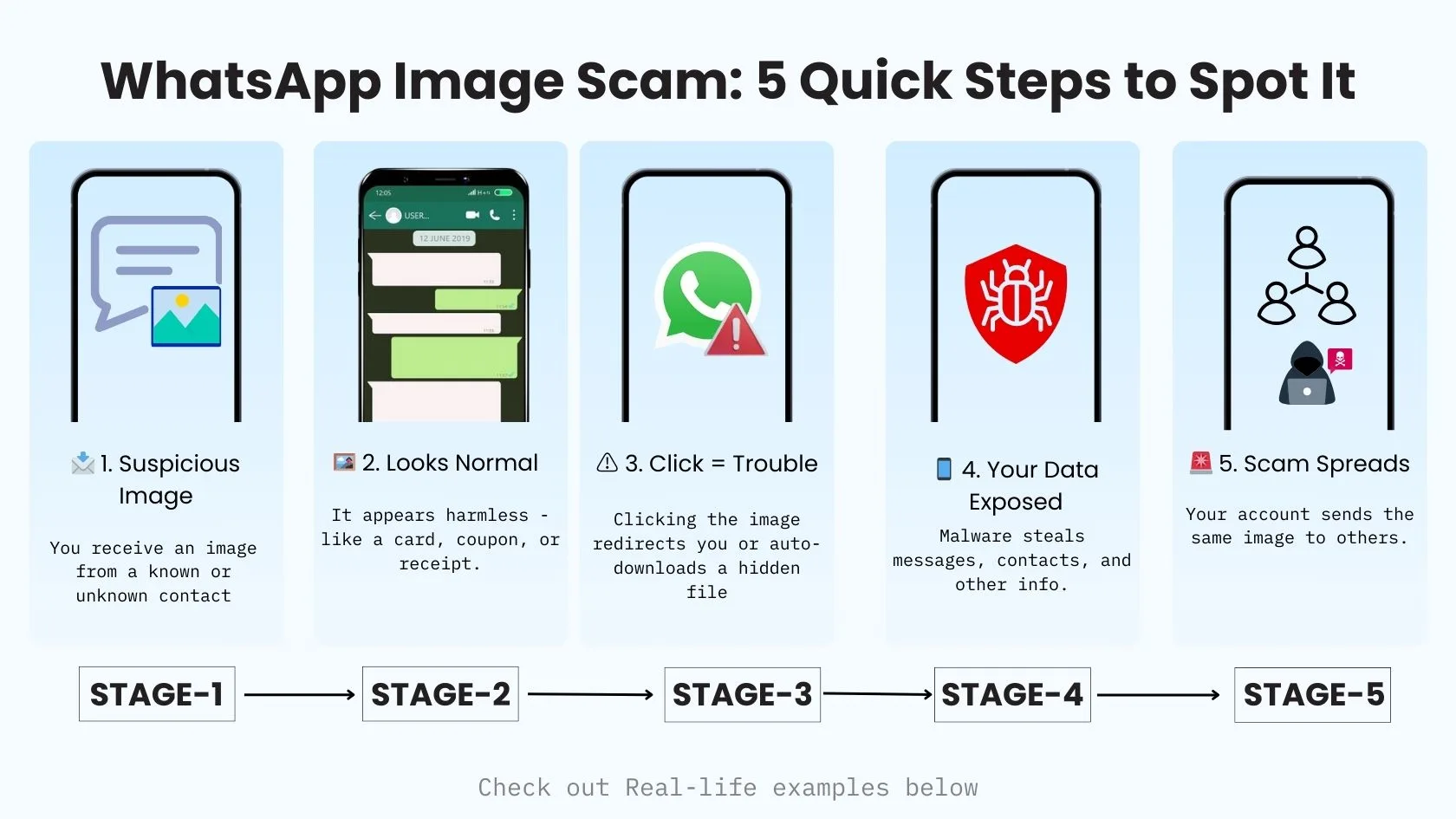WhatsApp Image Scam Warning: How It Works and How to Stay Safe
Scammers are hiding dangerous malware in WhatsApp images. Learn how these scams work, how to spot them, and protect your data with easy, actionable steps.
Author: Aasritha Sai
Scammers are hiding dangerous malware in WhatsApp images. Learn how these scams work, how to spot them, and protect your data with easy, actionable steps.
Author: Aasritha Sai

You’re looking through WhatsApp and chatting with your friends or family, and you get a picture from someone you don’t know. Maybe it’s a funny meme or a cute puppy. You open it without thinking, but later you notice something isn’t right. Your phone starts acting strange, or maybe your private information is at risk. These pictures, which seem harmless, can actually be scams. More and more people, just like you, are getting tricked. In this blog, we’ll explain how these scams work, how to spot them, and how you can stay safe.
A WhatsApp image scam happens when someone you don’t know sends you a message with an image attached. If you click on the image, it may contain something dangerous. The scammer could steal your personal details, like bank information or passwords, even though the image seems harmless. Always be careful before clicking on images from unknown senders.
The WhatsApp image scam is a new scam where cybercriminals send you an image file from an unknown number. When you click on the image, it could contain malicious data, using a technique called steganography. The scam can steal your bank details, OTPs, or even allow fraudsters to withdraw money from your bank account. This scam may also trick you into downloading an app or following a link.
The WhatsApp image scam is spreading fast because it looks harmless. Dangerous things are hidden inside images using a trick called steganography, which makes them hard to notice. When an image is received from an unknown sender on WhatsApp, it’s easy to think, "What could happen if this image is opened?" The danger is often not realized.
The scam continues to grow because nothing harmful is expected from an image that seems safe. Since the image looks normal, it might not be recognized as a scam.
The WhatsApp Image Scam happens when you get a picture from someone you don’t know. When you click on it, it can secretly harm your phone or steal your information. Even though the picture looks normal, it can hide something dangerous inside. In this section, you will learn about how the WhatsApp Image Scam works and how to protect yourself from it.
Here we’ll walk through the WhatsApp image scam, step by step, so you can easily spot it.

It starts when you get a message with an image. The message might come from a friend, family member, or even a stranger pretending to be someone you know. They’ll tell you the image is important or fun.
At first, the image looks totally fine. It might be a birthday card, a special offer, a delivery receipt, or something else that seems harmless. The scam is designed to make you think the image is important.
When you click the image, that’s when things go wrong. The link might take you to a fake website or automatically download something bad to your phone. This could be a virus or malware without you even realizing it.
Once the malware is on your phone, it can start stealing your personal information. It may access your contacts, messages, or even private details from other apps. This can lead to a loss of data or your phone getting infected.
The scam doesn’t stop with you. The malware may use your WhatsApp account to send similar messages or images to your friends and family. This puts your contacts at risk, and the scam continues to spread.
These scams aren’t just stories. They happen to many people every day and can cause serious problems. It’s important to understand how they work. Now, let’s see how these scams affect people in real life.
On March 28, Pradeep Jain from Jabalpur got a message on WhatsApp with a photo of an older person asking if he knew the person. At first, Pradeep thought it wasn’t important and ignored it. But after the stranger called him a few more times, he got curious and clicked on the photo. That’s when the hackers took control of his phone.
A few hours later, ₹2,01,000 was missing from his bank account. The scammers withdrew the money from an ATM located in Hyderabad. The photo had a virus hidden in it, and by clicking it, Pradeep unknowingly gave the hackers access to his bank details.
Scammers can cause a lot of trouble in your life if you fall for their tricks. They might steal your personal details, your money, and make things difficult for you. Here's what could happen:
In a WhatsApp image scam, hackers can gain access to your personal information, such as contacts and messages, simply by opening a suspicious image. Once they have control, they can also install harmful software on your phone, allowing them to monitor your activities.
Hackers can use this access to steal data, track your location, or even send messages from your account without you knowing. This can cause serious privacy and security issues.
If you fall for a WhatsApp image scam, scammers can gain access to your device when you click on the image. Once they have control, they can send the image to your friends and family by using your account.
As the scam spreads to more people, it becomes harder to stop. The more people who see it, the bigger the problem gets.
Scammers can make images on WhatsApp seem harmless, but they can lead to serious problems. They use fake images to trick you into sharing sensitive information like bank details or passwords, which can result in stolen money.
Your privacy is also at risk. Scammers can access personal data on your phone, such as photos and messages, and misuse it for harmful purposes.
Scams are becoming more common, so it's important to be careful when you receive images on WhatsApp. While most images are safe, some might contain harmful links or try to download dangerous files to your phone. To stay safe, it’s not just the image itself you need to watch for. Pay attention to the behavior of the sender, too. Now, let’s take a look at some common signs that an image could be a scam and the behaviors of the sender.
When you receive an image on WhatsApp, it’s important to stay alert. Scammers often hide harmful things inside image files to trick you. Here are signs that an image could be a scam:
The way the sender behaves can also give you hints that the message is a scam. Here are some behaviors to look for:

If you've clicked on a suspicious image, don't panic! Follow these steps to protect your phone and your personal information:
By following these steps, you can minimize the damage and stay in control of your online security.
Taking immediate action after encountering a WhatsApp image scam is crucial for protecting yourself and others. Reporting these scams not only helps authorities track cybercriminals but also ensures that the platform remains safer for everyone. If you've encountered a scam on WhatsApp or suspect you've been targeted, it’s important to report it. Here are some steps to take:
If you receive a suspicious message or image, you can report the user directly on WhatsApp. Here’s how:
WhatsApp will review the report and may take action against the user, such as blocking their account.
In India, you can report the scam to CERT-In (Computer Emergency Response Team) or your local cybercrime cell. Here’s how:
Reporting to CERT-In or your local cybercrime cell can help authorities trace the scammer and prevent further harm.
After you've reported the scam, it’s important to spread awareness to protect others. Share a warning in your WhatsApp groups and with individual contacts, explaining how the scam works and urging everyone to be cautious with unknown images or links. This helps ensure that others are informed and can avoid falling into the same trap.
WhatsApp image scams can trick anyone, but by taking quick action, you can protect yourself and others. If you ever receive a suspicious image, report it on WhatsApp, inform the authorities, and share the warning with others. This helps prevent more people from falling for this scam. Always be cautious when receiving images from unknown sources. If something doesn’t seem right, it’s better to ignore it!
Additionally, offer tips on staying safe online, such as advising them not to click on suspicious images and to report anything strange they encounter. By taking these steps, you contribute to a safer digital environment for everyone.